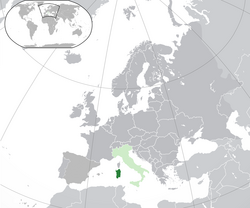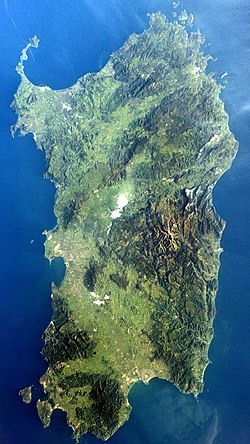This article should specify the language of its non-English content, using {{lang}}, {{transliteration}} for transliterated languages, and {{IPA}} for phonetic transcriptions, with an appropriate ISO 639 code. Wikipedia's multilingual support templates may also be used. (August 2022) |
Sardinia
| |
|---|---|
| Autonomous Region of Sardinia | |
|
| |
| Anthem: "Su patriotu sardu a sos feudatarios" (Sardinian) (English: "The Sardinian Patriot to the Lords") | |
| Coordinates: 40°N 9°E / 40°N 9°E | |
| Country | Italy |
| Capital | Cagliari |
| Government | |
| • Type | Consiglio Regionale |
| • President | Alessandra Todde (M5S) |
| Area | |
| • Total | 24,090 km2 (9,300 sq mi) |
| Population (2020) | |
| • Total | 1,628,384 |
| • Density | 68/km2 (180/sq mi) |
| • Languages | Italian and Sardinian |
| • Minority languages | |
| [1] | |
| Demonyms | |
| Citizenship | |
| • Italian | 97% |
| GDP | |
| • Total | €35.032 billion (2021) |
| Time zone | UTC+1 (CET) |
| • Summer (DST) | UTC+2 (CEST) |
| ISO 3166 code | IT-88 |
| HDI (2021) | 0.871[4] very high · 16th of 21 |
| NUTS Region | ITG |
| Website | www |

Sardinia (/sɑːrˈdɪniə/ sar-DIN-ee-ə; Italian: Sardegna [sarˈdeɲɲa]; Sardinian: Sardigna [saɾˈdiɲːa])[a][b] is the second-largest island in the Mediterranean Sea, after Sicily, and one of the twenty regions of Italy. It is located west of the Italian Peninsula, north of Tunisia and 16.45 km[5] south of the French island of Corsica.
It is one of the five Italian regions with some degree of domestic autonomy being granted by a special statute.[6] Its official name, Autonomous Region of Sardinia, is bilingual in Italian and Sardinian: Regione Autonoma della Sardegna / Regione Autònoma de Sardigna.[7] It is divided into four provinces and a metropolitan city. The capital of the region of Sardinia — and its largest city — is Cagliari.
Sardinia's indigenous language and Algherese Catalan are referred to by both the regional and national law as two of Italy's twelve officially recognized linguistic minorities,[8] albeit gravely endangered, while the regional law provides some measures to recognize and protect the aforementioned as well as the island's other minority languages (the Corsican-influenced Sassarese and Gallurese, and finally Tabarchino Ligurian).[9][10]
Owing to the variety of Sardinia's ecosystems, which include mountains,[11] woods, plains, stretches of largely uninhabited territory, streams, rocky coasts, and long sandy beaches,[12] Sardinia has been metaphorically described as a micro-continent.[13] In the modern era, many travelers and writers have extolled the beauty of its long-untouched landscapes, which retain vestiges of the Nuragic civilization.[14]
Cite error: There are <ref group=lower-alpha> tags or {{efn}} templates on this page, but the references will not show without a {{reflist|group=lower-alpha}} template or {{notelist}} template (see the help page).
- ^ "Statistiche demografiche ISTAT". demo.istat.it.[permanent dead link]
- ^ "Statistiche demografiche ISTAT". Demo.istat.it. Archived from the original on 6 August 2017. Retrieved 26 July 2019.
- ^ "Population on 1 January by age, sex and NUTS 2 region", www.ec.europa.eu
- ^ "Sub-national HDI – Area Database – Global Data Lab". hdi.globaldatalab.org. Retrieved 5 March 2023.
- ^ erasmus-plus.ec.europa.eu start: "Bonifacio 20169 Sartène", destination: "Lungòni/Santa Teresa Gallura 07028 Lungòni/Santa Teresa Gallura"
- ^ "Statuto - Regione Autonoma della Sardegna". www.regione.sardegna.it.
- ^ "Delibera della Giunta regionale del 26 giugno 2012" (PDF).
- ^ "Norme in materia di tutela delle minoranze linguistiche storiche", parlamento.it, Italian Parliament
- ^ "Legge Regionale 15 ottobre 1997, n. 26 - Regione Autonoma della Sardegna". www.regione.sardegna.it. Archived from the original on 1 March 2021. Retrieved 30 September 2013.
- ^ "Legge Regionale 3 Luglio 2018, n. 22". Regione autonoma della Sardegna – Regione Autònoma de Sardigna. Archived from the original on 5 March 2019. Retrieved 14 September 2021.
- ^ Ignazio Camarda, Montagne di Sardegna, pp. 11, 75
- ^ Fagiani, Caterina (31 July 2023). "Altro che Seychelles: le 5 spiagge caraibiche d'Italia". theWise Magazine (in Italian). Retrieved 8 May 2024.
- ^ Marcello Serra, Sardegna, quasi un continente, Cagliari,1958
- ^ Serra, Marcello. "Sardegna quasi un continente". sardegnadigitallibrary.it (in Italian). Archived from the original on 13 December 2018. Retrieved 25 September 2018.




